Lost in the Sky Cardigan |
|||||||||||||||||||||||||||||||
 |
 |
||||||||||||||||||||||||||||||
Knitted jacket with ¾ sleeves in DROPS Alpaca. Piece is knitted top down with raglan and lace pattern. Size: S - XXXL
DROPS 230-47 |
|||||||||||||||||||||||||||||||
|
---------------------------------------------------------- EXPLANATION FOR THE PATTERN: ---------------------------------------------------------- GARTER STITCH (back and forth): Knit all rows. 1 ridge vertically = knit 2 rows. PATTERN: See diagrams A.1 to A.9. Choose diagram for your size (applies to A.1 and A.7). Diagrams show all rows in pattern seen from the right side. RAGLAN: All increases are done from the right side. Increase 1 stitch on each side of stitch with marker by making 1 yarn over. On next row (wrong side) purl yarn over twisted to avoid holes. DECREASE TIP (applies to sleeves): Decrease 1 stitch on each side of marker thread as follows: Work until 3 stitches remain before marker thread and knit 2 together, knit 2 (marker thread is between these 2 stitches), slip 1 stitch knitwise, knit 1, pass slipped stitch over stitch worked. BUTTONHOLES (top down): Decrease for buttonholes on right band (when garment is worn). 1 buttonhole = work as before until 5 stitches remain on needle, make 1 yarn over, work the last 5 stitches as before. Turn piece, work the first 5 stitches as before, knit yarn over together with next stitch to make a hole. Decrease first buttonhole when piece measures approx. 2 cm. Then decrease the next 6-6-6-6-7-7 buttonholes, approx. 7-7½-7½-8-7-7½ cm apart. ---------------------------------------------------------- START THE PIECE HERE: ---------------------------------------------------------- JACKET - SHORT OVERVIEW OF THE PIECE: Work yoke back and forth on circular needle from mid front, work top down. Now divide yoke for body and sleeves. Work body back and forth on circular needle. Work sleeves in the round on double pointed needles/a short circular needle. YOKE: Cast on 137-137-137-159-159-159 stitches on circular needle size 2.5 mm with DROPS Alpaca. Purl 1 row from wrong side. Work next row as follows from right side: A.1, A.2, A.3 (these stitches belong to left front piece), work A.4 (insert 1 marker in first stitch in A.4), A.2, A.5 (insert 1 marker in last stitch in A.5 – stitches between these 2 markers belong to sleeve), A.6, A.2 is worked 3-3-3-4-4-4 times in total, A.3 (these stitches belong to back piece), A.4 (insert 1 marker in first stitch), A.2, A.5 (insert 1 marker in last stitch – stitches between these 2 markers belong to sleeve), A.6, A.2, A.7 (these stitches belong to right front piece). Continue pattern back and forth like this - the 4 stitches with markers marks the raglan lines and are used later for increase for raglan. When 2 rows have been worked back and forth, switch to circular needle size 3 mm, then continue pattern as before - REMEMBER THE KNITTING TENSION and remember BUTTONHOLES on right band - read explanation above. When A.1 to A.7 have been worked vertically, there are 209-209-209-229-229-229 stitches on needle. Then work in stocking stitch back and forth, but continue the outermost 8-8-8-10-10-10 stitches in each side as before (bands) – in addition work A.8 in the middle of each sleeve – stitch with star in A.8 should fit stitches with star in A.2. AT THE SAME TIME on first row from right side increase for RAGLAN – see explanation above. Increase 1 stitch on each side of 4 stitches with markers (8 stitches increased on row). Increase for raglan on every row from right side 16-20-24-27-30-35 times in total After last increase for raglan there are 337-369-401-445-469-509 stitches on needle and piece measures approx. 18-21-23-25-27-30 cm from cast-on edge. If piece is shorter than this, continue without increases until correct measurements. On next row divide piece for body and sleeves, i.e. work next row as follows: Work as before over the first 54-60-63-70-75-82 stitches, slip the next 69-73-83-91-93-99 stitches on a thread for sleeve, cast on 8-8-10-10-12-12 new stitches on needle (in the side under sleeve), work 91-103-109-123-133-147 stitches in stocking stitch, slip the next 69-73-83-91-93-99 stitches on a thread for sleeve, cast on 8-8-10-10-12-12 new stitches on needle (in the side under sleeve), and work the last 54-60-63-70-75-82 stitches as before. Finish body and sleeves separately. Now measure piece from here! BODY: = 215-239-255-283-307-335 stitches. Work stocking stitch back and forth with 8-8-8-10-10-10 band stitches in each side as before. When piece measures 22-21-21-21-21-20 cm from division, knit 1 row from right side while increasing 22-24-26-28-30-34 stitches evenly (do not increase over bands) = 237-263-281-311-337-369 stitches. Switch to circular needle size 2.5 mm, and work rib as follows: ROW 1 (= wrong side): 8-8-8-10-10-10 stitches as before, * purl 1 twisted, knit 1 *, work from *-* until 9-9-9-11-11-11 stitches remain on needle, purl 1 twisted and 8-8-8-10-10-10 stitches as before. ROW 2 (= right side): 8-8-8-10-10-10 stitches as before, * knit 1 twisted, purl 1 *, work from *-* until 9-9-9-11-11-11 stitches remain on needle, knit 1 twisted and 8-8-8-10-10-10 stitches as before. Repeat 1st and 2nd row until rib measures 3 cm. Loosely cast off. Jacket measures approx. 48-50-52-54-56-58 cm from shoulder and down. SLEEVE: Slip the 69-73-83-91-93-99 stitches from thread in one side of piece on double pointed needles or a short circular needle size 3 mm and pick in addition up 1 stitch in each of the 8-8-10-10-12-12 new stitches cast on under sleeve = 77-81-93-101-105-111 stitches. Insert 1 marker thread in the middle of the 8-8-10-10-12-12 stitches that were cast on under sleeves. Move marker thread upwards when working. Begin round at the marker thread and work stocking stitch in the round, but continue A.8 mid on top of sleeve as before. When sleeve measures 2-2-2-3-3-1 cm from division, decrease 2 stitches mid under sleeve - read DECREASE TIP. Decrease like this every 3½-2½-1½-1-1-1 cm 6-8-10-14-12-15 times in total = 65-65-73-73-81-81 stitches. Work until sleeve measures 24-22-21-19-17-16 cm from division. 9 cm remain until finished measurements. Knit 1 round while decreasing 1 stitch under sleeve (on right sleeve knit the last 2 stitches on round twisted together, on left sleeve knit the first 2 stitches on round together) = 64-64-72-72-80-80 stitches. Work A.9 8-8-9-9-10-10 times in total around the sleeve - A.9 should fit nicely over A.8 mid on top of sleeve. When A.9 has been worked, switch to double pointed needles size 2.5 mm. Continue rib over stitches in A.9 with knit 1 twisted/purl 1. When rib measures 1 cm (measured after A.9), increase every fourth purl 1 to purl 2 (i.e. increase every 8th stitch to purl 2) = 72-72-81-81-90-90 stitches. When rib measures 2 cm, increase the same way but displace to avoid increasing over previous increases = 80-80-90-90-100-100 stitches. When rib measures 3½ cm, increase the same way and displace to next 1 purl = 88-88-99-99-110-110 stitches, and when rib measures 5 cm, increase the remaining 1 purl to 2 purl = 96-96-108-108-120-120 stitches. Cast off somewhat loosely when rib measures 6 cm. Sleeve measures approx. 33-31-30-28-26-25 cm from division. Work the other sleeve the same way. ASSEMBLY: Sew the buttons on to the left band. |
|||||||||||||||||||||||||||||||
Diagram explanations |
|||||||||||||||||||||||||||||||
|
|||||||||||||||||||||||||||||||
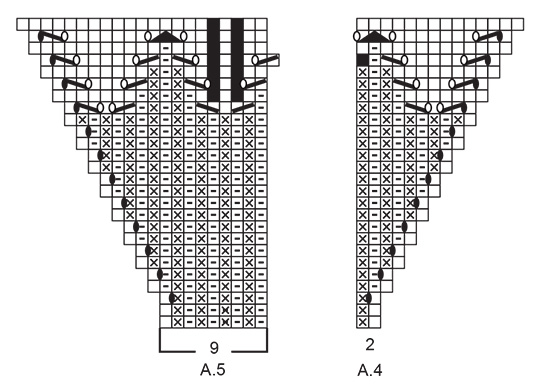
|
|||||||||||||||||||||||||||||||
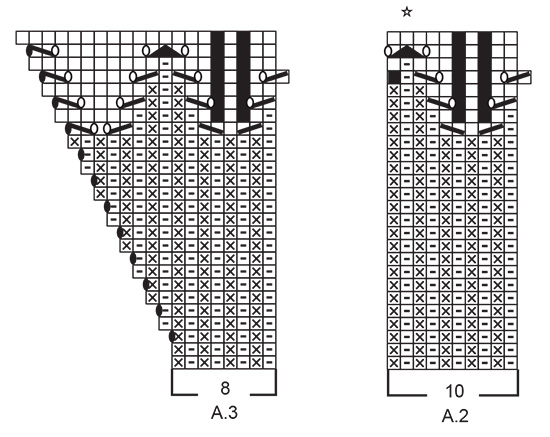
|
|||||||||||||||||||||||||||||||
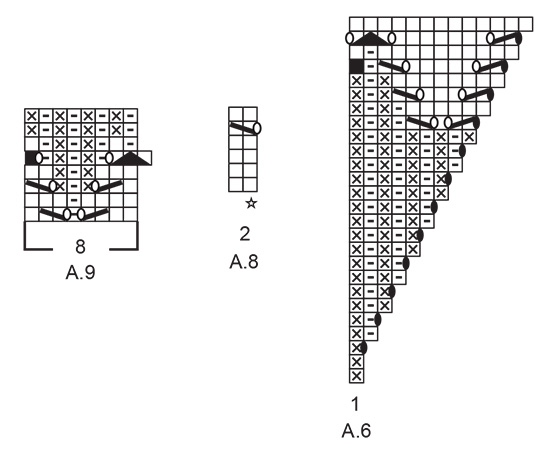
|
|||||||||||||||||||||||||||||||

|
|||||||||||||||||||||||||||||||
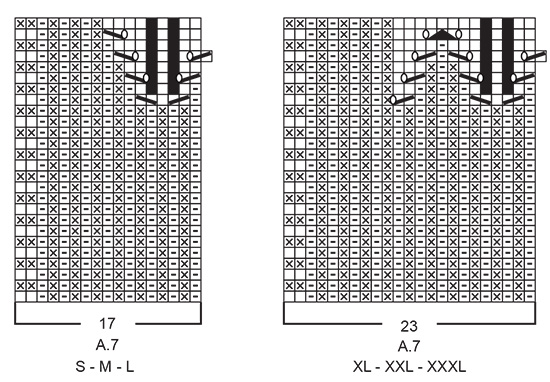
|
|||||||||||||||||||||||||||||||
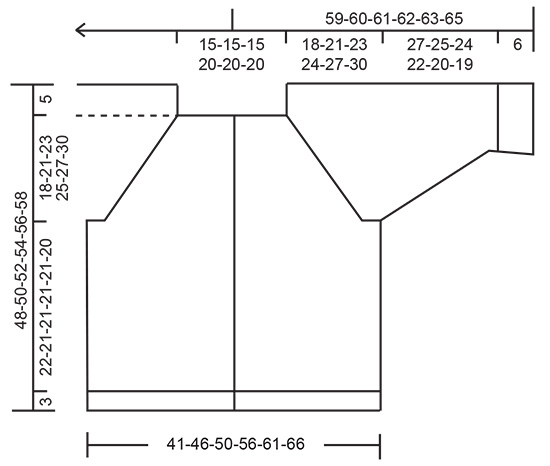
|
|||||||||||||||||||||||||||||||
|
Have you made this or any other of our designs? Tag your pictures in social media with #dropsdesign so we can see them! Do you need help with this pattern?You'll find tutorial videos, a Comments/Questions area and more by visiting the pattern on garnstudio.com. © 1982-2024 DROPS Design A/S. We reserve all rights. This document, including all its sub-sections, has copyrights. Read more about what you can do with our patterns at the bottom of each pattern on our site. |
|||||||||||||||||||||||||||||||







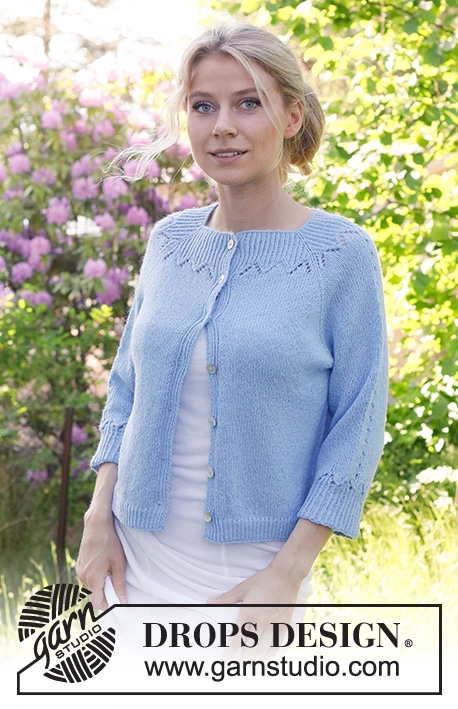
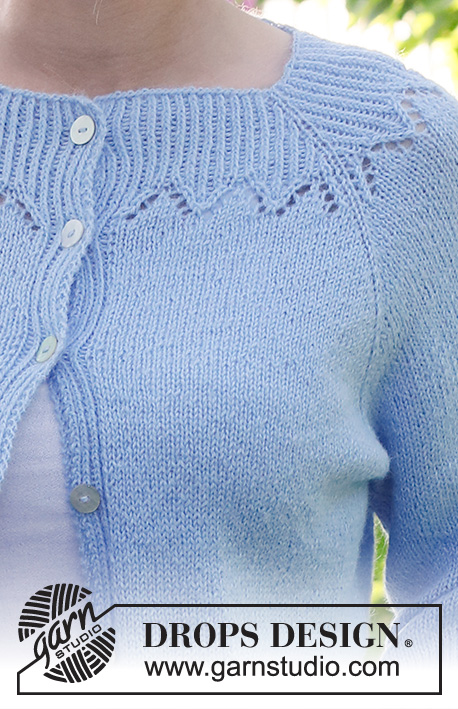

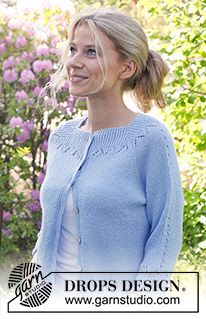

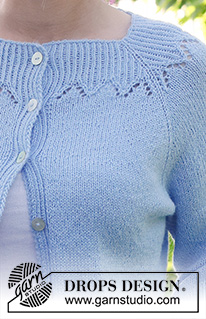


















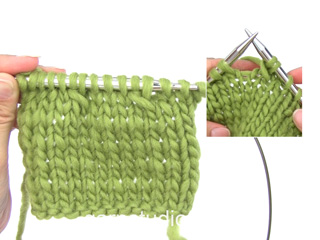




















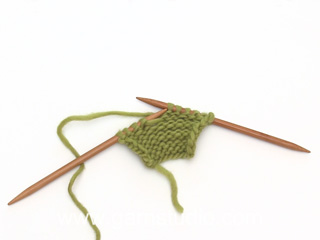



























Comments / Questions (22)
Grazie per la cortese risposta, proverò. Oriana
28.03.2024 - 21:19Buongiorno, mi piace molto questo modello, xo' non ho mai lavorato dall'alto in basso. Esiste la versione per poterlo lavorare dal basso in alto? Grazie
21.03.2024 - 14:54DROPS Design answered:
Buonasera Oriana, non esiste nessuna tecnica per lavorare dall'alto in basso, deve semplicemente seguire le istruzioni. Buon lavoro!
28.03.2024 - 19:27Hallo, verstehe es nicht ganz, also ich schlage die Maschen an, stricke die Rückreihe linkge Maschen, dann beginne ich mit der Einteilung und Muster, und dann nach den ersten zwei Musterreihen, das heisst also die dritte Musterreihe mit der Nadel Nr. 3 stricken .. Ist das so richtig. Also nicht erst wenn der Glatt rechte Teil beginnt mit Nadeln nummer 3 weiter glatt rechts stricken. Liebe Grüsse auf baldige Antwort. Ingrid Ehret
20.10.2023 - 15:05DROPS Design answered:
Liebe Frau Ehret, nein nicht genau, es wird dann insgesamt 3 Reihen mit den kleineren Nadeln gestrickt: 1 Rückreihe links + die 2 ersten Reihen mit Muster: Wenn 2 Reihen hin- und zurückgestrickt wurden, zu Rundnadel Nr. 3 wechseln.. Viel Spaß beim stricken!
20.10.2023 - 15:59Wann wechsele ich zur Nadel Nummer 3, so wie ich es verstehe in der 3. Reihe von Muster A 1, A 2, A 3 oder werden die Muster dzu Ende gestrickt (26 Reihen) und dann zur 3 er Nadel gewechselt ? Also nochmal, die ersten beiden Musterreihen mit 2,5 Nadel und dann weitter mit 3 er Nadeln. ? Bitte um baldige Antwort, da ich stzricken möchte.
20.10.2023 - 13:14DROPS Design answered:
Liebe Frau Ehret, wechseln Sie für die Nadeln Nr 3 nachdem die 2 ersten Reihen gestrickt werden. Viel Spaß beim stricken!
20.10.2023 - 14:15Hei! Jeg får ikke antall oppleggsmasker til å stemme, str M!!! Jeg legger opp 137 m og regnet ut : venstre og høyre forstykker = 28 m x 2 =56m, ermer 19 m x2 = 38m, og ryggstykke 41 m = totalt 135 m (pluss 2x2 raglan m) dette blir 139m. Beklager, men hva gjør jeg feil?
17.08.2023 - 20:14DROPS Design answered:
Hej Sissel A.1 = 10, A.2 = 10, A.3 = 8, A.4 = 2, A.2 = 10, A.5 = 9, A.6 = 1, A.2 = 10 x 3 = 30, A.3 = 8, A.4 = 2, A.2 = 10, A.5 = 9, A.6 = 1, A.2 = 10, A.7 = 17. = 137 masker
18.08.2023 - 12:02Co to znaczy "brak oczka, przejść bezpośrednio do kolejnego symbolu w schemacie"? Czy mam je przełożyć na drut bez przerobienia?
13.05.2023 - 23:45DROPS Design answered:
Witaj Beato, nie przekładasz oczka, tylko przerabiasz to oczko jak pokazuje kolejny symbol w schemacie. Pozdrawiamy!
14.05.2023 - 09:52Håller på med oket. Har stickat första varvet A1, A2, A3, A4, A2 4 ggr, A3, AA5, A6, A2 och A7. I vilken ordning ska jag sticka varvet tillbaka? Birgitta
19.04.2023 - 19:40DROPS Design answered:
Hei Birgitta. Da strikker du slik at A.1 kommer over A.1, A.2 over A.2, A.3 over A.3 osv. Og husk når du strikker frem og tilbake, vil annenhver pinne strikkes fra retten og annenhver pinne strikkes fra vrangen. Siden diagrammet viser alle masker sett fra rettsiden, må det derfor strikkes motsatt når det strikkes fra vrangen, du leser da raden fra venstre mot høyre, rettmasker strikkes vrang, vrangmasker strikkes rett (dette står i symbolforklaringen: «rett fra rettsiden, vrang fra vrangsiden»). mvh DROPS Design
24.04.2023 - 11:40Fråga om raglan ökningarna. Öka 1 maska på varje sida av maskorna med markör i genom att göra 1 omslag om stickan. På nästa varv (avigsidan) stickas omslagen vridet aviga, så att det inte blir hål. Om jag glömt att sticka omslaget vridet på avigsidan, har det någon betydelse för storleken? Stickar den i bomullsgarn så jag tycker inte att det gör något om det blir hål.
11.04.2023 - 19:29DROPS Design answered:
Hei Monica Nei, har ingen innvirkning på størrelsen (om det ikke har blitt et veldig stor hull). Men om det er bare et sted du glemte å stikke vridd, så blir det kanskje litt merkelig at det er et hull på den ene siden og ikke på den andre siden, men har du gjort det på alle steder du har økt, vil du bare få et ekstra hullmønster ved raglanslinjen :) mvh DROPS Design
17.04.2023 - 11:37Hei, prøver å lese dette mønsteret, og det jeg lurer på erom det er 8 eller 5 masker til stolpene? Og strikkes stolpene med 1 rett og 1 vrang..Litt forvirret her, så jeg håper dere kan hjelpe meg med dette..På forhånd tusen takk..Hilsen Maj Banner..Runcorn..Cheshire, England..
21.02.2023 - 11:10DROPS Design answered:
Hei Maj. Det kommer på hvilken str. du strikker. De 3 minste str har de 8 første maskene til stolpen og de 3 største str har 10 første maskene til stolpen (i A.1, se riktig diagram til riktig str) i den ene siden. På den andre siden er det de 8 og 10 siste maskene i diagram A.7. Se tekst forklaringen til diagrammene hvordan det strikkes (de 3 øverste ikonene). mvh DROPS Design
28.02.2023 - 19:25Hallo, es geht hier nicht um die Maschenzahl bei Ende des Diagrammes, sondern die Einteidlung der 19. Reihe stimmt nicht mit der vorhergehenden Reihe überein. Bitte überprüft dies doch mal und zählt die Maschen die 19. Reihe passt nicht auf die 18. Reihe (jeweils Vorderseitenreihen). Ich bitte um baldige Antwort da ich weiterstricken möchte. Liebe Grüse Ingrid Ehret
22.09.2022 - 14:10